Kristine Hughes's Blog, page 63
February 26, 2016
POST TOUR: THE VICTORIA AND ALBERT MUSEUM
POST TOUR: THE VICTORIA AND ALBERT MUSEUM
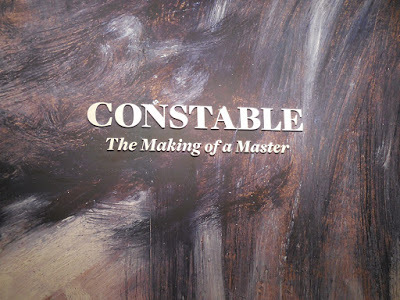
TO READ OUR ORIGINAL POST ON THIS TOPIC, CLICK HERE.
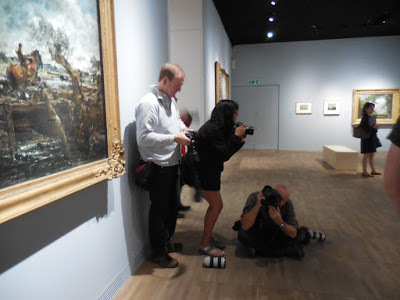 Press Opening of Constable Exhibit
Press Opening of Constable Exhibit
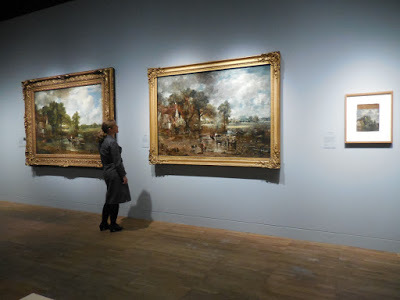
After we had our fill of Constable (as if that could ever happen!), we found lots of things to visit around the museum, lots more than we had time for. We started with coffee.
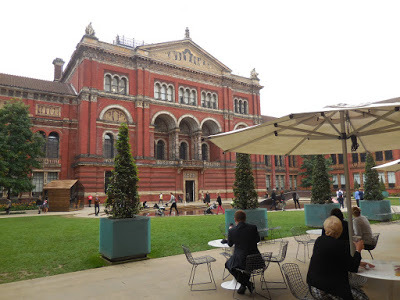 enjoying the outside in the courtyard
enjoying the outside in the courtyard
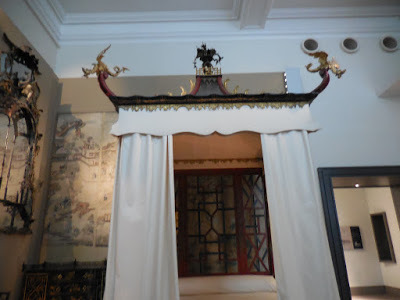 The Badminton Bed, 1754
The Badminton Bed, 1754
From Badminton House in Gloucestershire, the bed was designed by John Linnell and/or his brother William Linnell, and inspired by Chinese pagodas.The 4th Duke and particularly the Duchess of Beaufort were interested in the new craze for oriental works of art, and commissioned this bed for their home. A Copy of the Linnell bed is now in the house while the original is here in the museum.For pictures of the interior of Badminton House, click here. Scroll down to see the replica of the Badminton Bed.
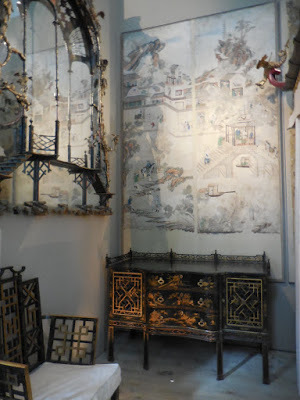 The Chinese Bedroom, from Badminton House
The Chinese Bedroom, from Badminton House
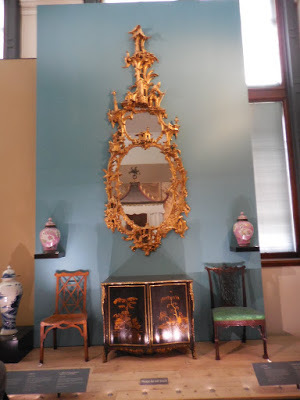 Chinoiserie display
Chinoiserie display
For more on chinoiserie at the V ad A, click here
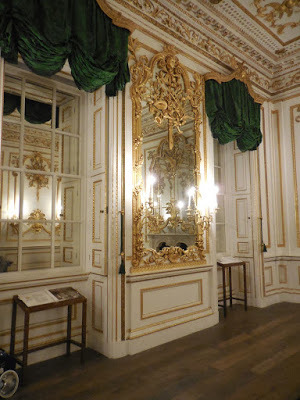 The paneling and doorways from Norfolk House at the Victoria and Albert Museum; it was the city home of the Dukes of Norfolk.
The paneling and doorways from Norfolk House at the Victoria and Albert Museum; it was the city home of the Dukes of Norfolk.
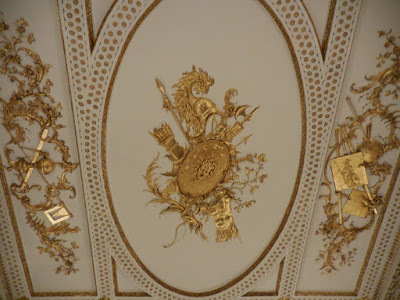 Ceiling from the Music Room of Norfolk House, 1756
Ceiling from the Music Room of Norfolk House, 1756
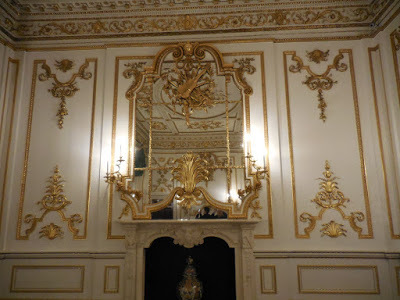 Norfolk House once stood in St. James's Square
Norfolk House once stood in St. James's Square
The house was demolished in 1938 after standing on the west side of St. James's Square since 1722. Most of the furnishings are now at Arundel Castle, home of the Dukes of Norfolk in West Sussex. For more information on the Music Room, click here.
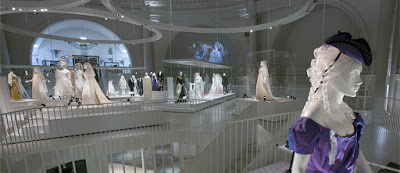 Wedding Dresses 1775-2014
Wedding Dresses 1775-2014
We were lucky enough to see the Wedding Dress from 1775-2014 Exhibition, at which no pictures were allowed.
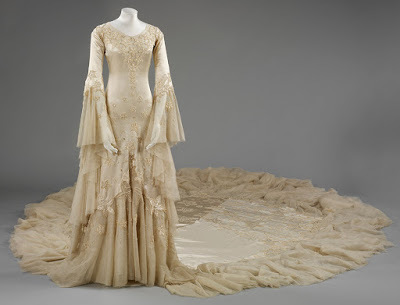 Silk satin wedding dress, designed by Norman Hartnell, 1933, Given and worn by Margaret, Duchess of Argyll. © Victoria and Albert Museum, London
Silk satin wedding dress, designed by Norman Hartnell, 1933, Given and worn by Margaret, Duchess of Argyll. © Victoria and Albert Museum, London
To read more about the exhibition, click here.
I never tire of visiting the V and A. It is overflowing with treasures of all kinds and full of excellent exhibitions from small to large. We had an afternoon appointment at Ben Franklin's House, so headed to Trafalgar Square.
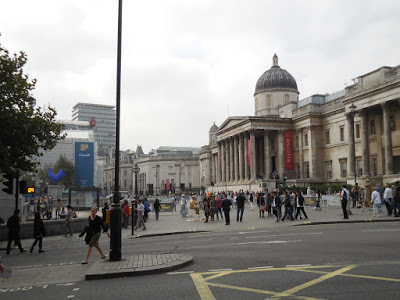
The blue rooster was the Fourth Plinth sculpture in 2014. Officially it was Hahn/Cock by Katharina Fritsch. It was replaced for the next 18-month stint on the Fourth Plinth by the politicially provocative Gift Horse by German-American artist Hans Haacke.
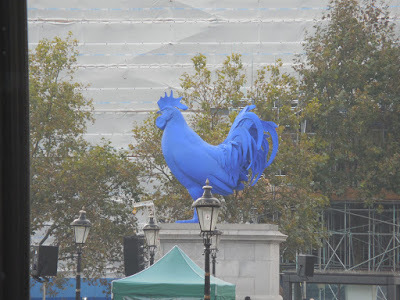
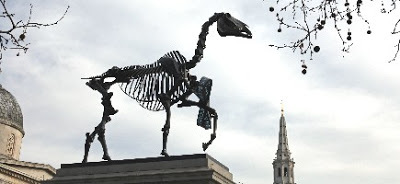 Photo from The Guardian
Photo from The Guardian
The skeleton in bronze has a stock-market ticker around its neck, So is it a symbol of Britain's lagging economy? Or a more robust interpretation of one of the healthiest economies in Europe, in the view of London Mayor Boris Johnson?
 Boots
Boots
It is only fair that we acknowledge the heroic efforts of Kristine to overcome her misery. Thus, frequent stops at Boots!
 All the warnings are posted!
All the warnings are posted!
Next stop just had to be a pub! More on our adventures with Sherlock Holmes in an upcoming post. Stay tuned.
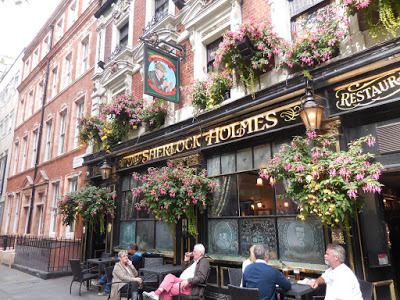
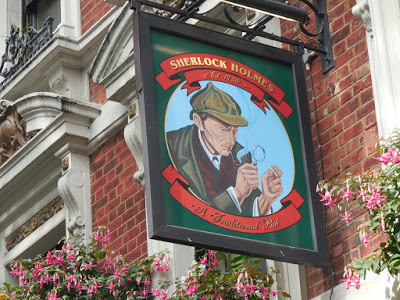

TO READ OUR ORIGINAL POST ON THIS TOPIC, CLICK HERE.
 Press Opening of Constable Exhibit
Press Opening of Constable Exhibit
After we had our fill of Constable (as if that could ever happen!), we found lots of things to visit around the museum, lots more than we had time for. We started with coffee.
 enjoying the outside in the courtyard
enjoying the outside in the courtyard The Badminton Bed, 1754
The Badminton Bed, 1754From Badminton House in Gloucestershire, the bed was designed by John Linnell and/or his brother William Linnell, and inspired by Chinese pagodas.The 4th Duke and particularly the Duchess of Beaufort were interested in the new craze for oriental works of art, and commissioned this bed for their home. A Copy of the Linnell bed is now in the house while the original is here in the museum.For pictures of the interior of Badminton House, click here. Scroll down to see the replica of the Badminton Bed.
 The Chinese Bedroom, from Badminton House
The Chinese Bedroom, from Badminton House Chinoiserie display
Chinoiserie displayFor more on chinoiserie at the V ad A, click here
 The paneling and doorways from Norfolk House at the Victoria and Albert Museum; it was the city home of the Dukes of Norfolk.
The paneling and doorways from Norfolk House at the Victoria and Albert Museum; it was the city home of the Dukes of Norfolk.  Ceiling from the Music Room of Norfolk House, 1756
Ceiling from the Music Room of Norfolk House, 1756 Norfolk House once stood in St. James's Square
Norfolk House once stood in St. James's SquareThe house was demolished in 1938 after standing on the west side of St. James's Square since 1722. Most of the furnishings are now at Arundel Castle, home of the Dukes of Norfolk in West Sussex. For more information on the Music Room, click here.
 Wedding Dresses 1775-2014
Wedding Dresses 1775-2014We were lucky enough to see the Wedding Dress from 1775-2014 Exhibition, at which no pictures were allowed.
 Silk satin wedding dress, designed by Norman Hartnell, 1933, Given and worn by Margaret, Duchess of Argyll. © Victoria and Albert Museum, London
Silk satin wedding dress, designed by Norman Hartnell, 1933, Given and worn by Margaret, Duchess of Argyll. © Victoria and Albert Museum, LondonTo read more about the exhibition, click here.
I never tire of visiting the V and A. It is overflowing with treasures of all kinds and full of excellent exhibitions from small to large. We had an afternoon appointment at Ben Franklin's House, so headed to Trafalgar Square.

The blue rooster was the Fourth Plinth sculpture in 2014. Officially it was Hahn/Cock by Katharina Fritsch. It was replaced for the next 18-month stint on the Fourth Plinth by the politicially provocative Gift Horse by German-American artist Hans Haacke.

 Photo from The Guardian
Photo from The GuardianThe skeleton in bronze has a stock-market ticker around its neck, So is it a symbol of Britain's lagging economy? Or a more robust interpretation of one of the healthiest economies in Europe, in the view of London Mayor Boris Johnson?
 Boots
BootsIt is only fair that we acknowledge the heroic efforts of Kristine to overcome her misery. Thus, frequent stops at Boots!
 All the warnings are posted!
All the warnings are posted!Next stop just had to be a pub! More on our adventures with Sherlock Holmes in an upcoming post. Stay tuned.


Published on February 26, 2016 00:00
February 23, 2016
REGENCY SCENTS BY GUEST BLOGGER MICHELLE STYLES
Originally published April 2008
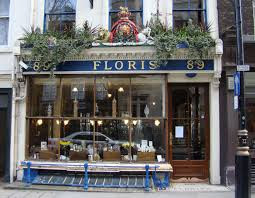
One of the delights of living in England is discovering how much survives from the Regency period (and in some cases before). I first came across Floris after reading an article about the men's clothing shop Hackett. Floris is a perfumery on JermynStreet and has occupied no 89 for about 250 years at least. It remains family run and the current head, John Bodenham is an 8th generation descendant of the founder Juan Famenias Floris. Floris was founded in 1730 and the shop has a small museum full of scent bottles and combs that I go and look at every time I am in London. The shop is lovely -- all glass and mirrors with wonderful scents. The Spanish mahogany cases were acquired in 1851 from the Great Exhibition. However, I was never that sure when a particular scent was created. I simply knew that I liked them. Stephanotis is beautiful and I fell in love with Malmaison earlier this year. Their Lily of the Valley is heavenly. And my dd adores Edwardian Bouquet. And to the wearer of particular scent, that is all that matters.
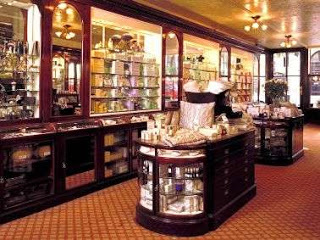
But when were the scents developed? And can I use them in my books? What were people in the Regency period actually wearing. Recently the Floris catalogue has been giving details about its scents and when they were developed.
Lily of the Valley was developed about 250 years ago. So say around 1758 -- making it a Georgian scent. Its top notes are green and lemon with heart notes of jasmine, lily of the valley,rose and tuberose. The base note is musk. Another Georgian scent Floris does is Limes and that was developed in the late 1700s to combat the awful smells and heat of the London summer.
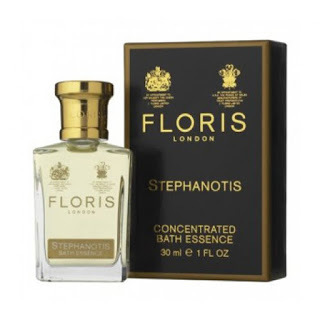
Stephanotis was developed in 1796 by the son of the founder -- James Floris. It combines the scents of the traditional bridal bouquet and was made because James Floris noticed how many brides were getting in and around St James. So what the Regency society bride might have worn. And it is truly lovely -- top note orange blossom, heart notes of carnation, coriander, lily of the valley, stenphanotis, jasmine with base notes of musk, powdery notes and sandalwood. In the flower language that was popular at the time, stephanotis means good luck. Another Regency fragrance is the Night Jasmine scent that was inspired by the jasmine scent that John Floris created in 1806. The floral design imprinted on their soaps dates from the early 19th century.
Malmaison is late 19th century by the way and is based on the Malmaison carnation, one of the more fashionable flowers of the late Victorian period. Apparently Oscar Wilde used to wear Malmaison carnations. The Malmaison scent is far heavier than the Stephanotis or Lily of the Valley. Top notes of cinnamon, cloves and lemon with heart notes of malmaison carnation, rose ,ylang and base notes of cedarwood, musk, patchoui, and vanilla. The Floris catalogue lists Malmaison under its classicfragrances -- suitable for either men or women. My dad's favourite Edwardian Bouquet dates from 1901 and was a celebration of the new era. It is a lovely floral scent.
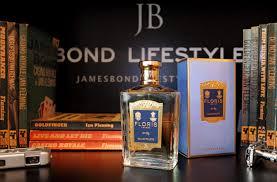
Anyway, it goes to show that a good scent can stand the test of time. And with its wide range of scents (Ian Fleming had James Bond wear no 89 for example) , there is a good reason why Floris is thriving today. But I thought I would toss out a few of the more historic scents in case people were interested. Floris does ship worldwide, but a visit to its shop in Jermyn Street should be a must for any one interested in the Georgian or Regency periods.
Please visit Michelle Styles's author blog here.

One of the delights of living in England is discovering how much survives from the Regency period (and in some cases before). I first came across Floris after reading an article about the men's clothing shop Hackett. Floris is a perfumery on JermynStreet and has occupied no 89 for about 250 years at least. It remains family run and the current head, John Bodenham is an 8th generation descendant of the founder Juan Famenias Floris. Floris was founded in 1730 and the shop has a small museum full of scent bottles and combs that I go and look at every time I am in London. The shop is lovely -- all glass and mirrors with wonderful scents. The Spanish mahogany cases were acquired in 1851 from the Great Exhibition. However, I was never that sure when a particular scent was created. I simply knew that I liked them. Stephanotis is beautiful and I fell in love with Malmaison earlier this year. Their Lily of the Valley is heavenly. And my dd adores Edwardian Bouquet. And to the wearer of particular scent, that is all that matters.

But when were the scents developed? And can I use them in my books? What were people in the Regency period actually wearing. Recently the Floris catalogue has been giving details about its scents and when they were developed.
Lily of the Valley was developed about 250 years ago. So say around 1758 -- making it a Georgian scent. Its top notes are green and lemon with heart notes of jasmine, lily of the valley,rose and tuberose. The base note is musk. Another Georgian scent Floris does is Limes and that was developed in the late 1700s to combat the awful smells and heat of the London summer.

Stephanotis was developed in 1796 by the son of the founder -- James Floris. It combines the scents of the traditional bridal bouquet and was made because James Floris noticed how many brides were getting in and around St James. So what the Regency society bride might have worn. And it is truly lovely -- top note orange blossom, heart notes of carnation, coriander, lily of the valley, stenphanotis, jasmine with base notes of musk, powdery notes and sandalwood. In the flower language that was popular at the time, stephanotis means good luck. Another Regency fragrance is the Night Jasmine scent that was inspired by the jasmine scent that John Floris created in 1806. The floral design imprinted on their soaps dates from the early 19th century.
Malmaison is late 19th century by the way and is based on the Malmaison carnation, one of the more fashionable flowers of the late Victorian period. Apparently Oscar Wilde used to wear Malmaison carnations. The Malmaison scent is far heavier than the Stephanotis or Lily of the Valley. Top notes of cinnamon, cloves and lemon with heart notes of malmaison carnation, rose ,ylang and base notes of cedarwood, musk, patchoui, and vanilla. The Floris catalogue lists Malmaison under its classicfragrances -- suitable for either men or women. My dad's favourite Edwardian Bouquet dates from 1901 and was a celebration of the new era. It is a lovely floral scent.

Anyway, it goes to show that a good scent can stand the test of time. And with its wide range of scents (Ian Fleming had James Bond wear no 89 for example) , there is a good reason why Floris is thriving today. But I thought I would toss out a few of the more historic scents in case people were interested. Floris does ship worldwide, but a visit to its shop in Jermyn Street should be a must for any one interested in the Georgian or Regency periods.
Please visit Michelle Styles's author blog here.
Published on February 23, 2016 23:30
February 21, 2016
THE DUKE OF WELLINGTON TOUR: SIGNS WE SAW HERE AND THERE

At Highclere Castle

Eton

Eton

Windsor

Hampstead

Burgh House, Hampstead

Burgh House, Hampstead

London

Bank Underground station, London

Highclere Castle

Stratfield Saye

Reading
\

Deal

Deal
Published on February 21, 2016 23:00
February 19, 2016
POST TOUR WINDSOR: ST. JOHN'S CHURCH
POST TOUR WINDSOR: PARISH CHURCH OF ST. JOHN THE BAPTIST
Not far along the High Street (toward the Great Park)from the Guildhall and Museum is the Parish Church of Windsor, St. John the Baptist. Victoria here, again, wandering the sights while Kristine languished in her sickbed.
I am always curious to get a look at pretty churches so I went in for a visit. Built in 1822, it followed the old Gothic Style of architecture. With enlargements, it can seat 1,000 people and is a frequent venue for weddings and other ceremonial events as well as parish functions.
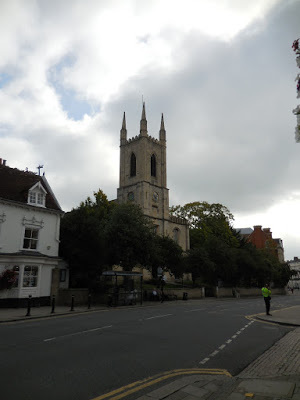
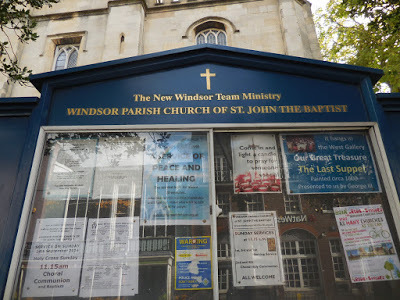
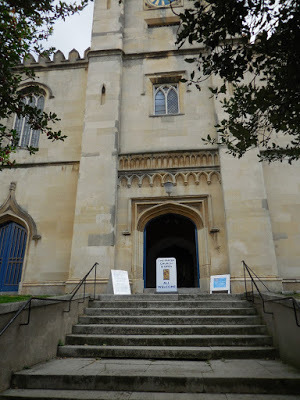
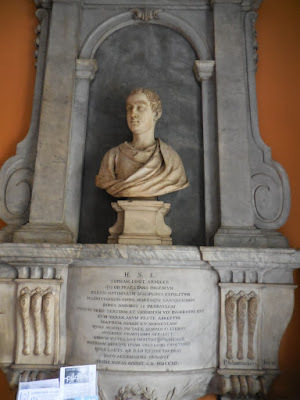 Memorial to Topham Foote, d. 1712, one of a prominent family in Windsor history
Memorial to Topham Foote, d. 1712, one of a prominent family in Windsor history
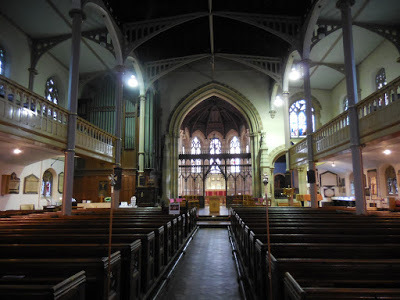
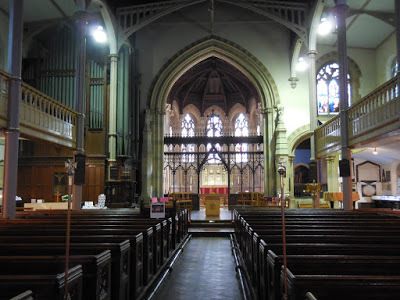
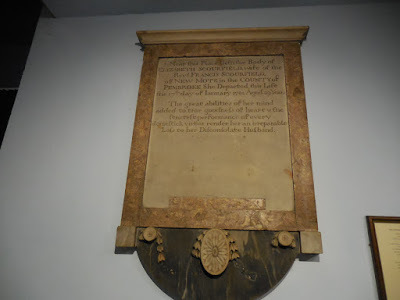 When the ancient church was rebuild in the early 19th century, the memorials were preserved.
When the ancient church was rebuild in the early 19th century, the memorials were preserved.
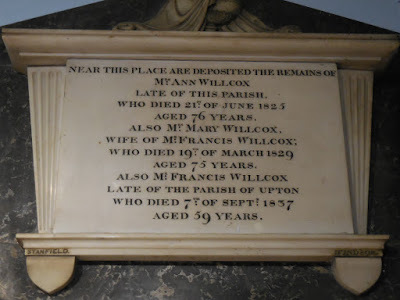
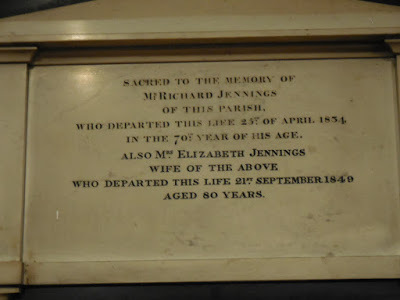
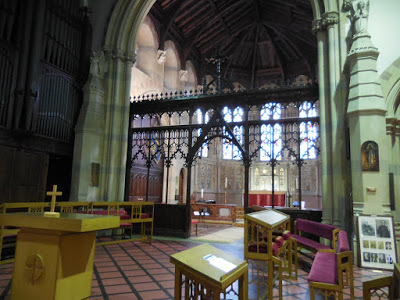
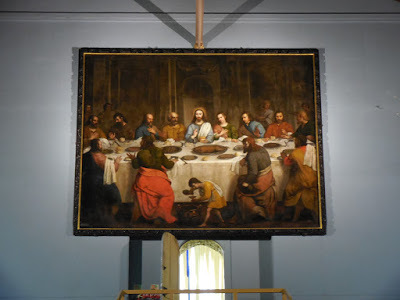 This Representation of The Last Supper was painted by Francis de Cleyn (c. 1582-1658), painter to King James I, also well known as a designer of Mortlake Tapestries. Holland House contains many of his works.
This Representation of The Last Supper was painted by Francis de Cleyn (c. 1582-1658), painter to King James I, also well known as a designer of Mortlake Tapestries. Holland House contains many of his works.
The painting was presented to St. George's Chapel in 1660 by the Bishop of Winchester, later presented to the Parish Church by George III. For more details, click here.
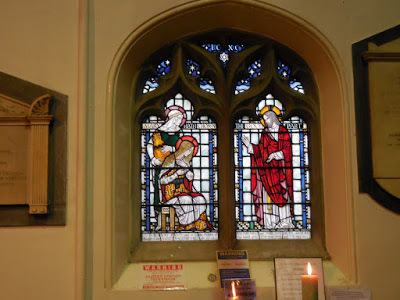
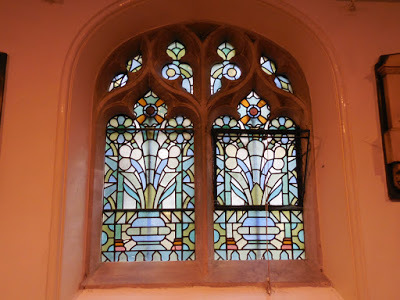 Beautiful stained glass
Beautiful stained glass
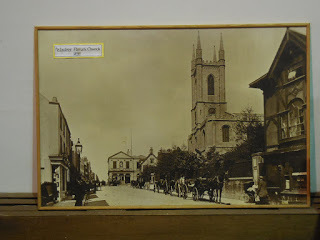 Old photo looking toward the Guildhall from in front of the church
Old photo looking toward the Guildhall from in front of the church
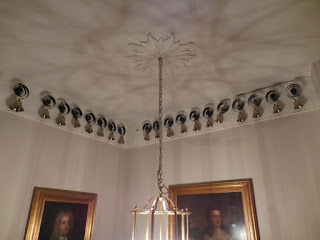 a large set of bells
a large set of bells
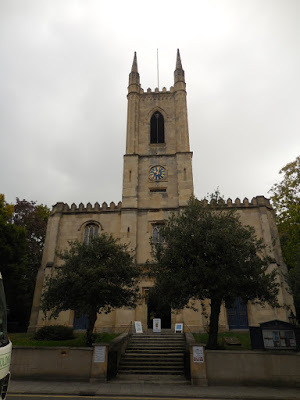
Not far along the High Street (toward the Great Park)from the Guildhall and Museum is the Parish Church of Windsor, St. John the Baptist. Victoria here, again, wandering the sights while Kristine languished in her sickbed.
I am always curious to get a look at pretty churches so I went in for a visit. Built in 1822, it followed the old Gothic Style of architecture. With enlargements, it can seat 1,000 people and is a frequent venue for weddings and other ceremonial events as well as parish functions.



 Memorial to Topham Foote, d. 1712, one of a prominent family in Windsor history
Memorial to Topham Foote, d. 1712, one of a prominent family in Windsor history

 When the ancient church was rebuild in the early 19th century, the memorials were preserved.
When the ancient church was rebuild in the early 19th century, the memorials were preserved.


 This Representation of The Last Supper was painted by Francis de Cleyn (c. 1582-1658), painter to King James I, also well known as a designer of Mortlake Tapestries. Holland House contains many of his works.
This Representation of The Last Supper was painted by Francis de Cleyn (c. 1582-1658), painter to King James I, also well known as a designer of Mortlake Tapestries. Holland House contains many of his works.The painting was presented to St. George's Chapel in 1660 by the Bishop of Winchester, later presented to the Parish Church by George III. For more details, click here.

 Beautiful stained glass
Beautiful stained glass  Old photo looking toward the Guildhall from in front of the church
Old photo looking toward the Guildhall from in front of the church a large set of bells
a large set of bells
Published on February 19, 2016 00:00
February 16, 2016
A FEW OF VICTORIA'S FAVOURITE SIGNS
Published on February 16, 2016 23:30
February 14, 2016
A LOOK AT VAUXHALL GARDENS
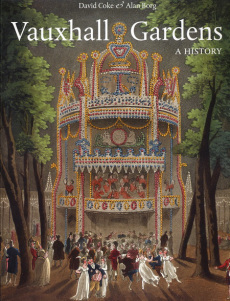

Recently, author Susana Ellis ran a 23 part series about the history of Vauxhall Gardens on her blog, based upon the fabulous coffee table book she aquired, above. Chock full of historical tidbits and images, the series is not to be missed by anyone interested in the Gardens or London history. You'll find Part One of the series here.
I'm sure we all wish that the Gardens still existed so that we could wander the grounds and buildings and imagine ourselves walking beside the notables who promenaded the lanes whilst listening to the bands and watching the magnificent illuminations. Personally, I would have loved to have been there for the Waterloo Celebrations. These days, it often takes a lot of imagination to be able to disregard the trappings of modern London in order to envisage the past. On a prior trip to London, I stood upon Hampstead Heath and gazed down upon the City proper, imagining what the place might have looked like in the dark of night, with footpads and highwaymen laying in wait for unlucky travellers foolish enough to cross the Heath on moonless nights. I also walked the grounds of Ranelagh Gardens, now an offshoot of the grounds of the Royal Chelsea Hospital. No Rotunda, alas, nothing left but the images one carries in the mind and the heart.
Fortunately, intrepid seekers of the remnants of Vauxhall Gardens can contact London Trails, a London based company that offers walking tours using routes that follow old maps. Their Vauxhall Gardens tour is on my bucket list.
Published on February 14, 2016 23:30
February 11, 2016
POST-TOUR: LITERARY WINDSOR
While Kristine slept...Victoria went wandering, finding a Tour of Literary Windsor on my agenda.
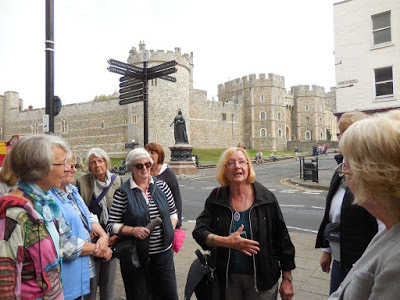
Queen Victoria was the first literary figure we discussed. The Queen not only wrote extensively; she was also an accomplished artist in water colors.
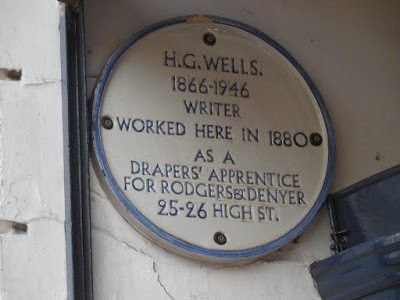
On the High Street we found a plaque honoring H. G. Wells who worked here in 1880.
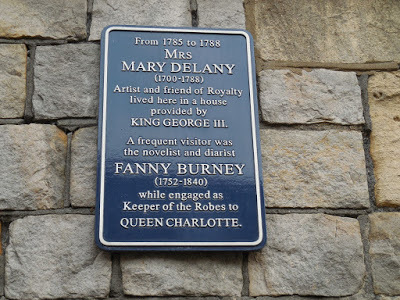
On a wall near the castle, a sign commemorates Mrs. Delaney, an artist, and Fanny Burney, noted novelist and playwright.
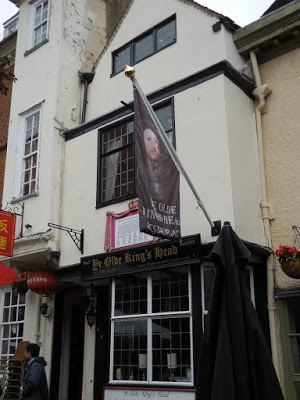
Ye Olde King's Head dates from the time of Henry VIII and was reputedly the home of Shakespeare while he wrote The Merry Wives of Windsor.
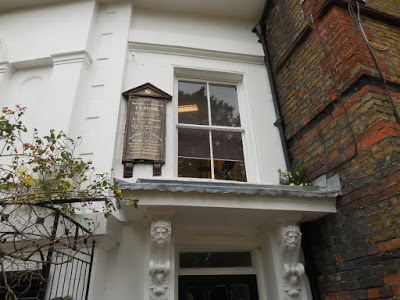
Above and below, home of poet and hymnist S. J. Stone (1836-1900). One of his most famous is "The Church's One Foundation," 1866
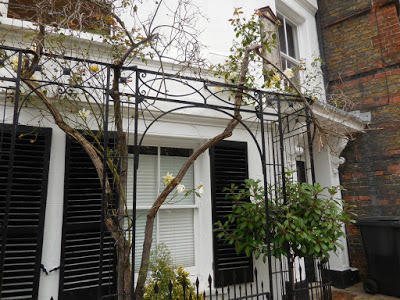
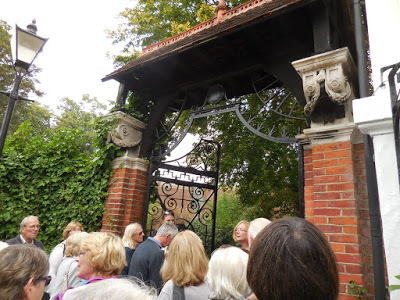
The tour at the gateway to the park Bachelors Acre which honors editor and publisher Charles Knight (1791-1873
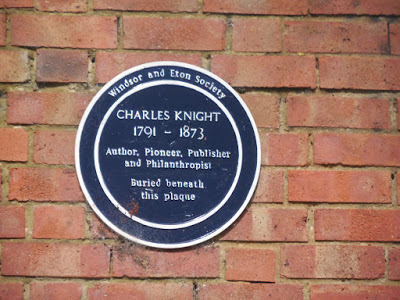
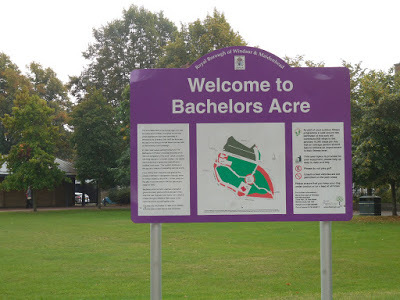 Map of the park
Map of the park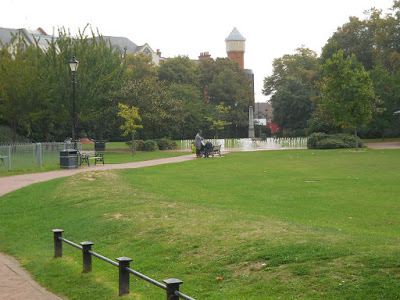 A quiet day in Bachelors Acres
A quiet day in Bachelors Acres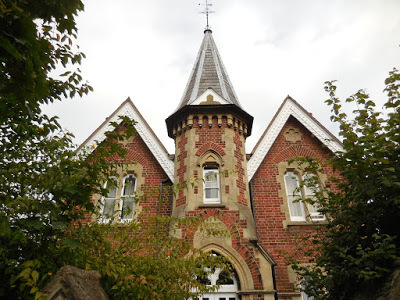
Above and below Joseph Chariott's House; the Victorian philanthropist built many almshouses in Windsor.
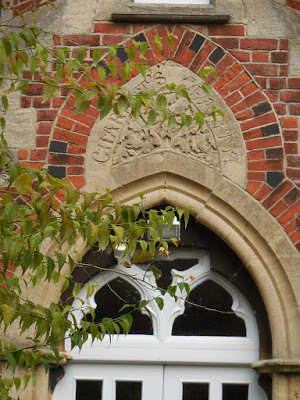
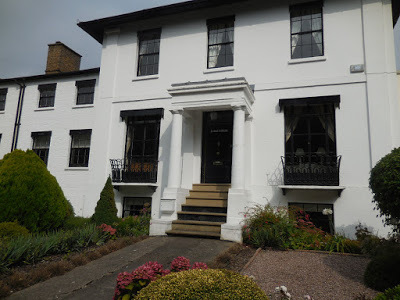
Our last stop was Oliphant House, residence of Margaret Oliphant, a 19th century novelist and historian who lived here in Clarence Crescent; she wrote more than 120 books.
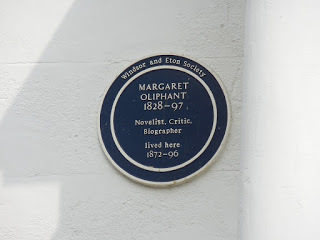
It was time now to pack up and depart Windsor, Kristine's misery not withstanding. We decided to take a taxi to our next stop in Hampstead- quite a long ride, but efficiently accomplished as we prepared ourselves for more adventures ahead.
Published on February 11, 2016 23:30
February 9, 2016
THE DUCHESS OF DEVONSHIRE AUCTION
This March, Sotheby's, London, will be auctioning items belonging to
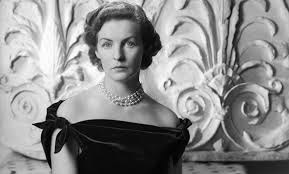
Deborah, Duchess of Devonshire: The Last of the Mitford Sisters
2 March | London
Born into English society as the youngest of the Mitford Sisters, Deborah, Duchess of Devonshire was unfailingly elegant yet down-to-earth. This March, Sotheby’s will offer more than 450 objects from her personal collection, including jewellery, works by artist friends like Lucian Freud, family photos and charming hen-related objects.
I admit here that I have always had a special affinity for this Duchess, as for her predecessor, Georgiana.
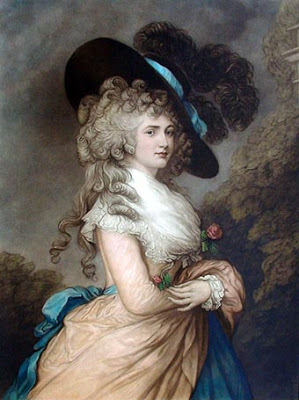
Both women lead spectacular lives, albeit for different reasons, but each was a star in her own right. I believe that their connections to Chatsworth House adds to my affections, as Chatsworth remains my personal favourite Stately Home.
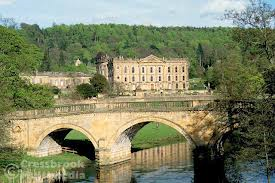
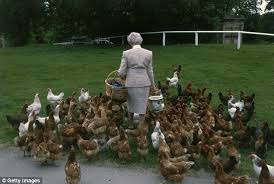
Still, you have to admire Deborah Mitford, who grew up in a stellar family and who married a minor member of the aristocracy, who ascended to the dukedom when his elder brother was killed in WWII. Through it all, the Duchess remained Debo to all - her down to earth, get it done mindset allowed her and the Duke to pull Chatsworth from the brink of bankruptcy and turn it into the most successful of British estates and a model for other members of the peerage who afterwards opened their own homes to the public. Through it all, the Duchess remained true to herself and to her love of country pursuits, including her involvemet in championing many breeds of British livestock, including her beloved hens, which can still be seen at Chatsworth. The Duchess was also an ardent fan of Elvis Presley.
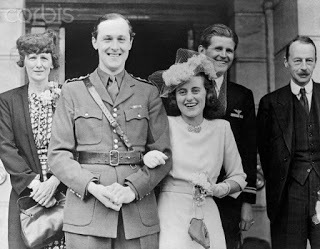
Deborah would never have become Duchess had the Duke's elder brother, William Cavendish, Marquess of Hartington, who was married to Kathleen "Kick" Kennedy, sister to the President, not died before him. You can read more about that chapter of Chatsworth history here.
For more background on Deborah, Duchess of Devonshire and the auction, you will find the article from the Daily Mail here.
And you will find a slideshow of limited items from the Sotheby's sale on their website here.
Published on February 09, 2016 23:30
February 8, 2016
DESIGN YOUR OWN WIG
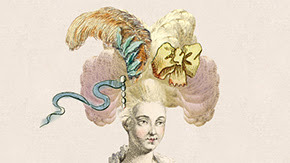
Use the Victoria and Albert Museum's interactive app to design your very own wig. Sculpt, decorate, powder and then share your masterpiece on social media.
Published on February 08, 2016 00:00
February 4, 2016
POST-TOUR WINDSOR: QUEEN VICTORIA'S LOO
While we were in Windsor after the tour Kristine, of course, came down with the usual malady she suffers through on each of her trips over. Thank goodness it waited to arrive until after the Tour was finished. While she lay dying in bed at the hotel, I trotted off to see a few Windsor sights I had missed on previous visits. Nothing like a good friend in need, I thought. But to tell the truth she was in no mood to be either entertained or conversed with. The best thing I could do was let her sleep!!
One place I was eager to see was the special area in the Windsor and Eton Railroad Station that had been reserved for the use of Queen Victoria and her attendants back in the day.
I had long heard it was in the station, but where? That station has been turned into shopping mall -- which we had visited to enthuse over the Jo Malone shop -- a favorite of both of us for special luxurious and fragrant cosmetics, Never saw the Queen's loo. But when I enquired at the station, I was pointed in the direction of All Bar One restaurant at the far end.
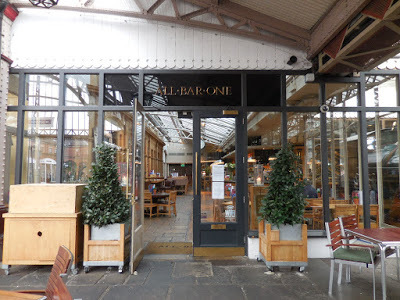
And indeed, it was entirely open to the public, if you knew it was there. The writing on the door says 'This room is reserved' -- but the proprietors are perfectly willing to allow one inside.
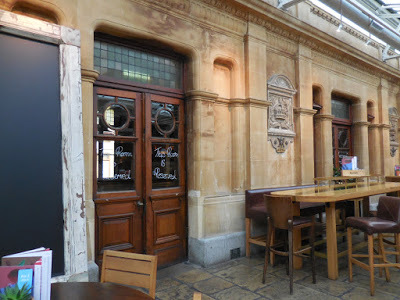
It was fitted out as a special private dining room -- not the actual loo of course, but the associated small waiting rooms used by the Royal party.
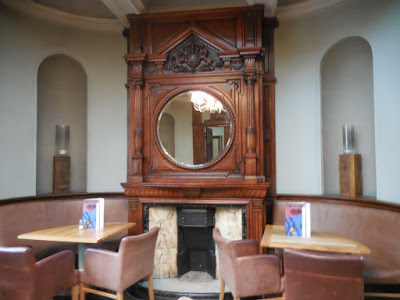
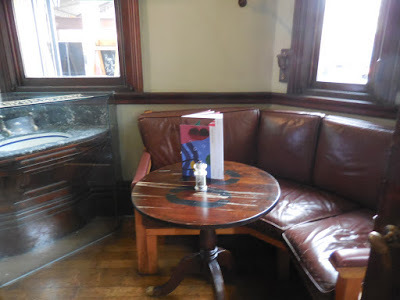
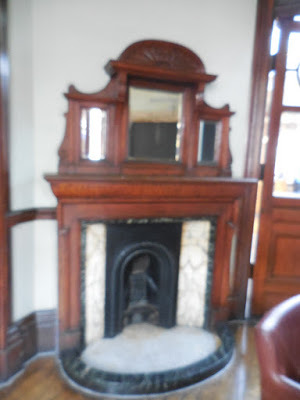
The basin and loo were actually glassed off, either to protect them or to continue the exclusivity...if Queen Elizabeth II happened by, would they allow her to use the facility???
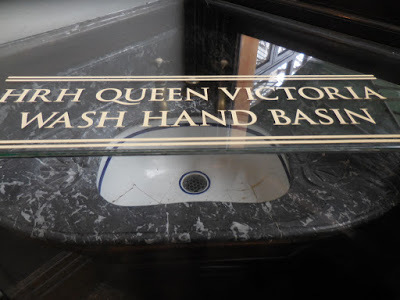
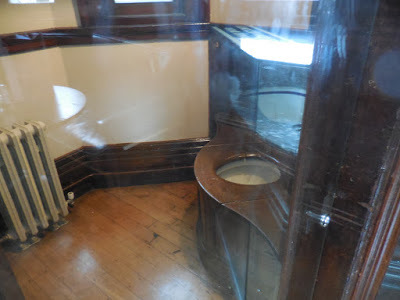
Just outside All Bar One, was a non-working locomotive.
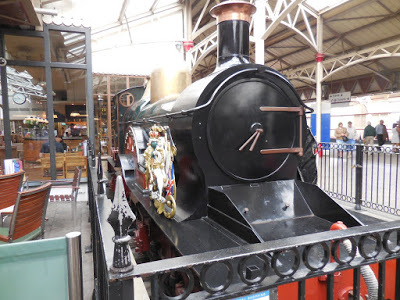
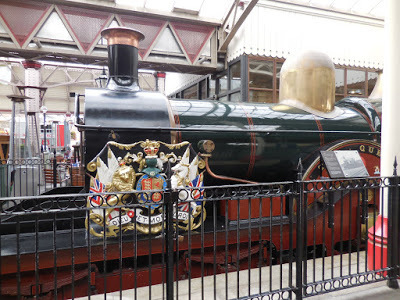
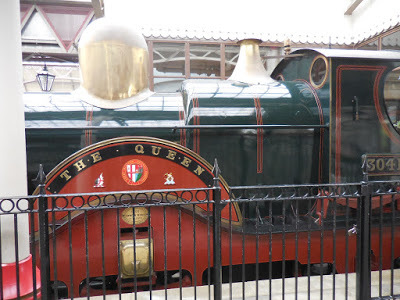
It seems that the locomotive is about all that is left from displays formerly set up on the station by Madame Tussaud's wax museum, no longer in operation in Windsor.
The text panel reads: The locomotive is a full scale replica of the GWR Achilles class 4-2-2 locomotive No. 3041. It was built in 1804 and originally named "Emlyn" after Lord Emlyn, Chairman of the Great Western Railway Company. Repainted in 1897, in GWR livery, the great locomotive, 57 feet long was renamed "The Queen" especially to pull the six new carriages of the Royal Train. No examples of these locomotives survive today and "The Queen" (later renamed "James Mason") was withdrawn from service in 1912.
Next time you are in Windsor, check it out! Not as stunning as the Castle, but an amusing sidelight on the Queen who was the first Royal to use the railroads for her travel.
Published on February 04, 2016 23:30
Kristine Hughes's Blog
- Kristine Hughes's profile
- 6 followers
Kristine Hughes isn't a Goodreads Author
(yet),
but they
do have a blog,
so here are some recent posts imported from
their feed.



















